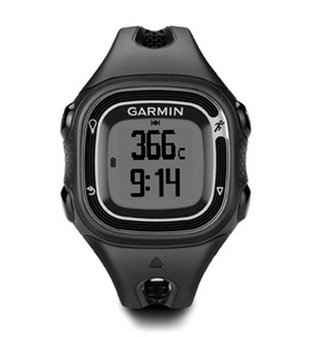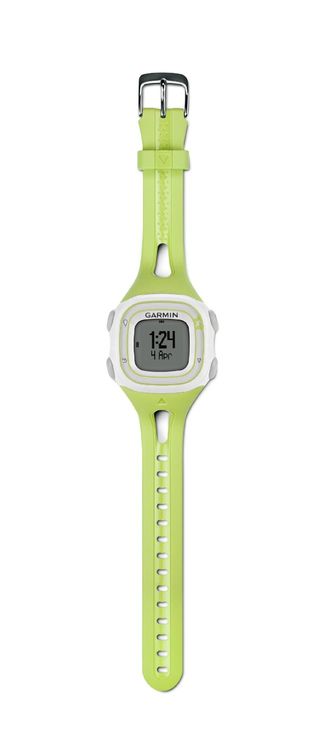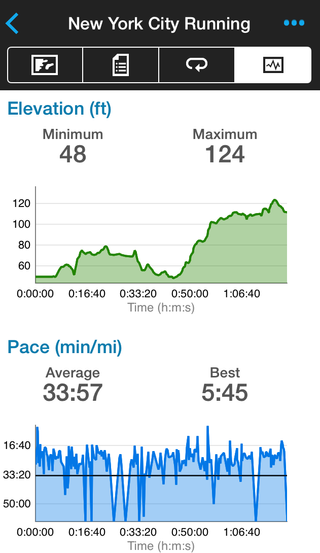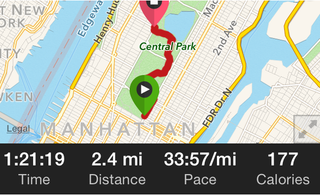Garmin Forerunner 10: GPS Watch Review

The Garmin Forerunner 10 is a GPS watch for walkers or runners that tracks distance, elevation, pace and calories burned. The device retails for $92.37, making it one of the least expensive GPS watches on the market. It's cheaper than the $299 TomTom Multi-Sport Cardio, the $409 Polar V800 and the $490 Garmin Forerunner 920XT. Granted, the Garmin Forerunner 10 doesn't have as many features as these other watches (for instance, it doesn't track sleep, swimming, steps or heart rate), but it efficiently tracks walking and running workouts.
The watch is easy to use and comfortable to wear. It enables fitness enthusiasts to track their average and best paces, and chart their routes using GPS data. In addition, users can set a preferred pace, and the watch will keep them on target by beeping if they go too slowly or too quickly while training. I wore the Forerunner 10 over the course of a week. Here's what I found:
Overall rating: 6/10
The Forerunner 10 is an adept device that tracks running and walking workouts. The small watch fit comfortably on my wrist, and didn't feel heavy while I was running. It is water-resistant in shallow water, which means you can keep it on for nonintensive water sports. [Best GPS Running Watches]
The device, which doubles as a regular watch that tells the time and date, is a GPS-enabled fitness tracker that calculates your time, distance, calories burned and pace. It also records your personal best time or speed, and will collect your average stats, which you can share with your friends online.
However, the watch does not have wireless or Bluetooth capabilities, so you can only upload your workouts online (unlike other GPS watches that can be paired with your smartphone). I also found it difficult to hear the watch when it beeps, and sometimes it took several minutes for the device to pick up a GPS signal. But, for less than $100, it's a good running watch for beginners or bargain hunters.
Design/comfort 7/10

The Forerunner 10 has a flexible rubber wristband, and it's easy to put on and take off. The watch comes in two sizes and a variety of colors, such as pink/white, green/white, violet/white and black/silver. The smaller watch's body measures 1.58 by 2.05 by 0.62 inches (40.1 by 52.2 by 15.7 millimeters), and is also fairly light, weighing 1.3 ounces (36 grams).
Sign up for the Live Science daily newsletter now
Get the world’s most fascinating discoveries delivered straight to your inbox.
The larger versioncomes in black/red and orange/black, with a body that measures 1.79 by 2.25 by 0.62 inches (45.5 by 57.2 by 15.7 mm). It weighs 1.5 ounces (43 g).
I tested the small, black/silver watch and found it comfortable and relatively slim. Still, the watch body was bulky enough that it was hard to pull it over my coat sleeve when I was tracking a walk on a cold day. But I had no problem checking the watch during my workouts when I was wearing loose-fitting sleeves.
The four buttons on the device are easy to press. The watch can also be programmed to beep at specific intervals — for instance, when you complete a mile — but it isn't always easy to hear the chime. I rarely heard the watch beep when I used it in a noisy, urban environment.
User Friendliness: 5/10
With just four buttons, the watch is easy to use. Like any other GPS watch, you need to be outside for it to properly pinpoint your location and automatically set the time and date. (GPS signals have trouble detecting devices that are inside buildings.) Once the time and date are set, you can wear the device like a regular watch, and the battery should last up to five weeks. [Best Fitness Tracker Bands]

However, when GPS is activated, the battery life will be shorter — just five hours, according to Garmin. For people who use the GPS function for 30 minutes each day, the watch will last for about 10 days without needing to be recharged. This battery life makes the watch suitable for half-day activities, but if you tend to log lengthy workouts, you may find yourself running out of juice — for instance, if your marathon time tops the five-hour mark.
Other GPS watches have longer-lasting batteries. The Polar V800 GPS watch lasts 13 hours on a single charge, and the Garmin Forerunner 920XT lasts for 24 hours in GPS mode.
To start tracking your workout, simply press the "run" button to enable GPS, and then press it again to start monitoring your workout. If you're exercising in an urban location, surrounded by tall buildings, it can take up to 10 minutes for the watch to establish a satellite lock. I noticed that the GPS feature "gives up" if it takes too long to find a signal, which means you have to restart the search by pressing the button again.
However, in more suburban locations, or in open spaces, the Forerunner 10 was able to pick up a satellite signal within a minute or so.
The watch screen displays two stats at a time, and one of the buttons on the side lets you toggle to the next screen. The device is programmed to show the time and distance on one screen and the calories and pace on the next, but users can also customize their settings to show pace and distance at once, according to Garmin.
During a workout, you can press the "run" button again to pause the timer. Once your workout is over, the watch will give you a summary, showing your distance, total time, average pace and calories burned. The watch will save your last seven runs on the watch, which is handy if you want to quickly glance at your recent workout history.
To keep track of all your workouts, you need to download Garmin Connect for free on your computer. The watch does not have Bluetooth capabilities, but it comes with a cable that lets you charge the watch and upload data to your computer. The Garmin Connect site has several interactive options. You can post your data online and share it with friends, set goals, and earn badges for certain accomplishments, such as your fastest mile. You can also pair the information on Garmin Connect with other applications, such as MyFitnessPal, which tracks how many calories you eat.
You can download the free Garmin Connect Mobile app on your iPhone, iPad or iPod touch, but again, the app can't sync wirelessly with the watch; you need to first upload your data to Garmin Connect on your computer to see your stats on your smart device. [Best Fitness Apps for 2015]
The Forerunner 10 is also water-resistant up to 164 feet (50 meters), meaning you can wear it in the shower or if you're swimming or snorkeling near the water's surface, according to Garmin.
Value of information 5/10
I found it valuable to learn my total distance, time, calories burned and pace. The Forerunner 10 also charts your personal records, such as your longest run or fastest mile, and notifies you of these milestones online.

Both the online site and app provide useful information about your workouts. For instance, I took a lazy Sunday stroll in Central Park in New York City last weekend. After I uploaded the data, I learned that I had walked 2.4 miles and gained 96 feet (29 m) in elevation in about an hour and 20 minutes. When I uploaded the data to my computer, I could see a map of my route, and I was even able to pick out where I had lingered in one spot taking pictures. It would be fun to take this watch hiking so you could map your path along a mountain's winding trails.
I didn't use the Virtual Pacer, which beeps if you go too fast or too slow compared to your preferred speed, but I imagine it would be useful for athletes training for a marathon or triathlon. The watch also has a run/walk mode that beeps at set intervals, to let you know when it's time to run or walk, depending on your training regimen.
However, the watch does not track your heart rate or steps taken — two metrics that some other GPS fitness devices do record. For instance, the Fitbit Surge is a GPS watch that tracks your daily steps and has a built-in heart-rate sensor. But at $250, the Surge costs quite a bit more than the Forerunner 10.
The Forerunner 10 collects useful running metrics, but the watch and Garmin Connect don't provide much context for those numbers. For instance, I had no idea how my average pace and distance compared to other people my age, or people who are similar in weight and height. When I reviewed the Jawbone UP Move fitness tracker, the device's accompanying app suggested I take 10,000 steps a day to keep up with my peers, which I found to be helpful advice.
Enjoyment/inspiration: 7/10
I barely noticed the lightweight GPS watch during my workouts, which is key to integrating it into your workout routine. I also found it motivating, and I often pushed myself to increase my pace when the watch alerted me that my speedhad slowed.
What's more, it was fun uploading my runs to the online site, so I could map my progress and see the elevation and distance covered. New York City is fairly flat, but I would be keen to see the elevation gained during a mountainous hike or bike ride in my native, hilly Seattle.
It was annoying to have to wait for the GPS to sync sometimes, and it's inconvenient that you need a cable to upload your workouts onto the computer, but those small inconveniences aside, I found the Forerunner 10 easy to use and a great motivational partner.
More Reviews: See all our GPS watch reviews to find the best one for your needs.
Follow Laura Geggel on Twitter @LauraGeggel. Follow Live Science @livescience, Facebook & Google+.

Laura is the archaeology and Life's Little Mysteries editor at Live Science. She also reports on general science, including paleontology. Her work has appeared in The New York Times, Scholastic, Popular Science and Spectrum, a site on autism research. She has won multiple awards from the Society of Professional Journalists and the Washington Newspaper Publishers Association for her reporting at a weekly newspaper near Seattle. Laura holds a bachelor's degree in English literature and psychology from Washington University in St. Louis and a master's degree in science writing from NYU.
Most Popular


